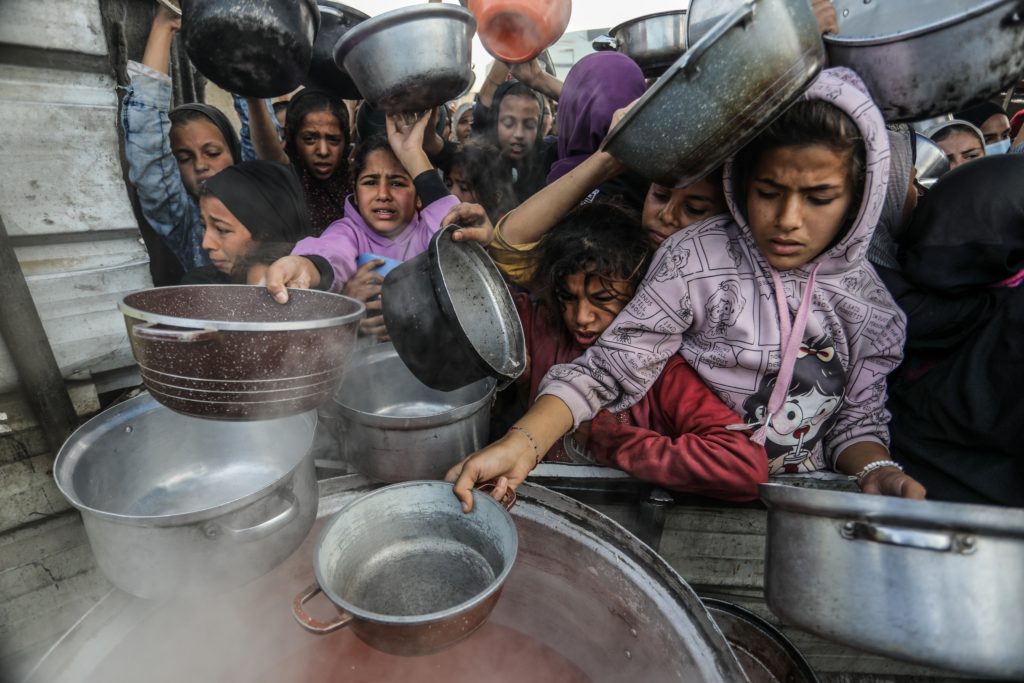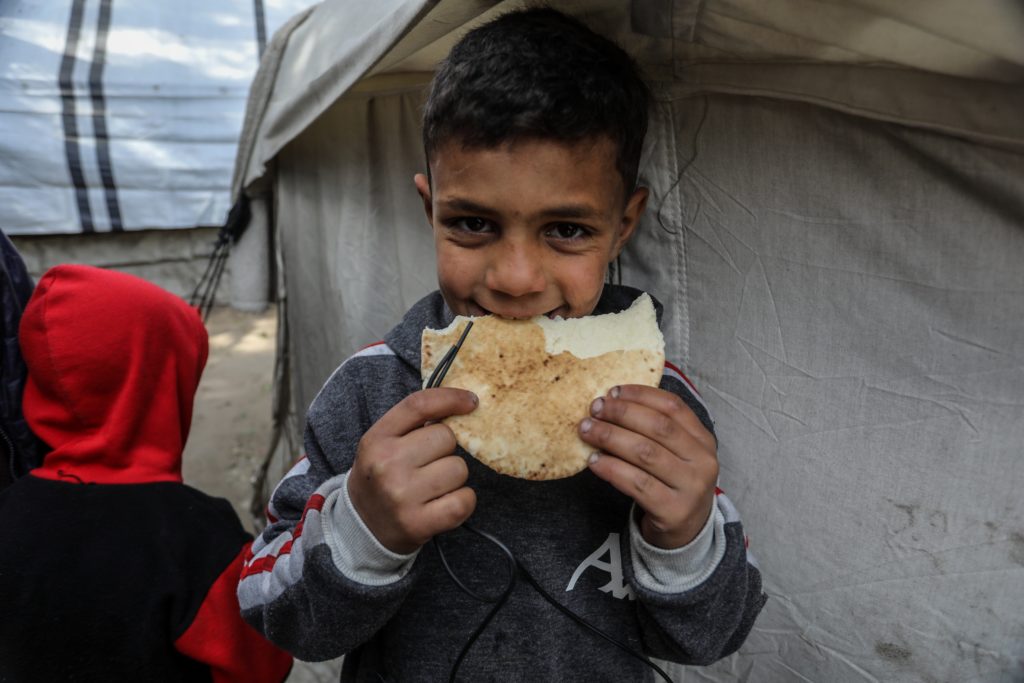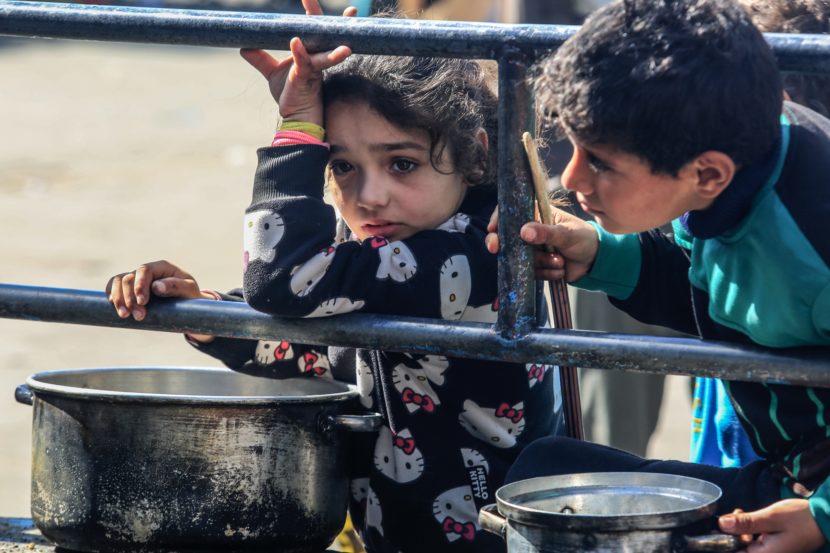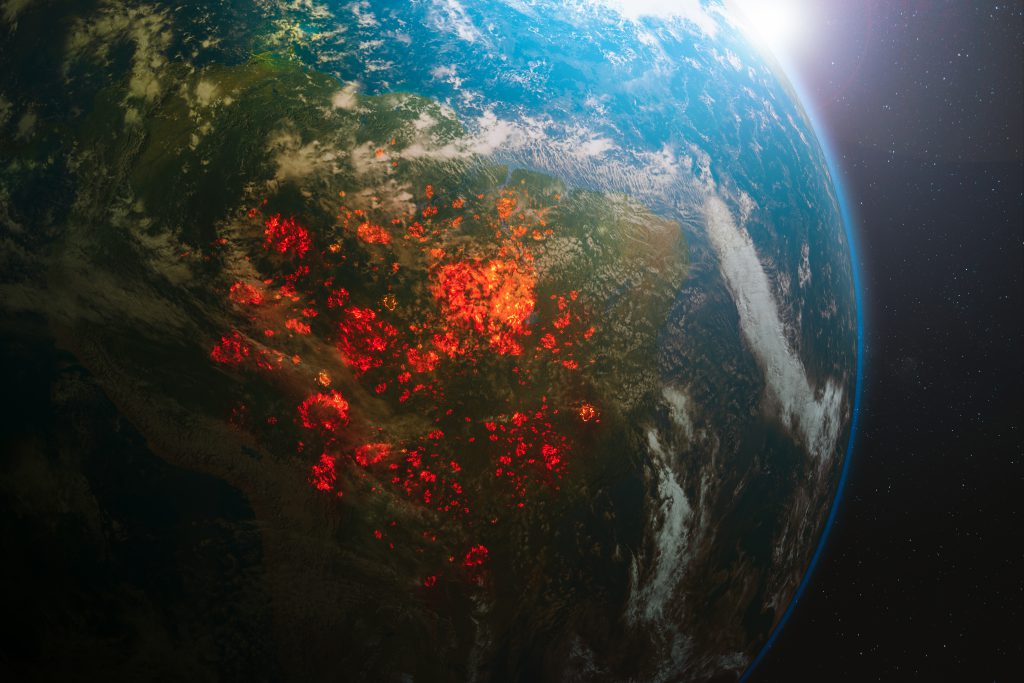Since the escalation of Israel’s attack on Gaza in October 2023, hunger in the besieged enclave has surged to record levels – with children suffering the most. More than 495,000 people are now facing catastrophic food shortages, and families are surviving on as little as 245 calories per day, barely 12% of the minimum daily requirement. Thousands of children have already been hospitalized for acute malnutrition. Immediate, unrestricted humanitarian access is urgently needed to prevent further loss of life.
Background of the humanitarian crisis in Gaza
Gaza has faced a long-standing humanitarian crisis driven by decades of land, air, and sea blockade imposed by Israel, which severely restricts the movement of people, goods, food, and medical supplies in and out of the territory. The prolonged isolation has weakened the economy, leaving 80% of the population reliant on aid (UNCTAD, 2023).
However, the situation sharply deteriorated after the escalation of military operations in October 2023. Israeli airstrikes and ground attacks destroyed homes, hospitals, water systems, and key infrastructure, leaving more than two million people in urgent need of humanitarian support (World Food Program, 2025).
Since March 2, 2025, relief supplies have been almost entirely blocked from entering Gaza, causing a major surge in hunger (World Food Program, 2025). The residents have been surviving on an average of just 245 calories per day – less than 12% of the minimum daily requirement – forcing families to subsist on wild plants and herbs (Oxfam, 2024).
“Israel is making deliberate choices to starve civilians. Imagine what it is like, not only to be trying to survive on 245 calories day in, day out, but also having to watch your children do the same.”
– Amitabh Behar, Oxfam International Executive Director (Oxfam, 2024)
Starvation is no longer a byproduct of war; it is now being directly caused by the conflict. The systems people rely on to survive – farms, markets, water supplies – have been destroyed or blocked. The British Red Cross warns that continued restrictions may result in additional deaths from malnutrition (British Red Cross, 2025).
Children represent 80% of hunger-related deaths in Gaza
“When you see babies start to die, panic and alarms should start to flare. Essentially, children are the first to die in starvation crises.”
– Dr. Thaer Ahmad, Emergency Medicine Physician who served in Gaza in 2024 (The Guardian, 2025)
More than 100 people have died from lack of nutrition since the war began, and children account for 80% of those deaths (UNICEF, 2025). One of the victims was four-month-old Jinan Iskafi, who died after her hospital couldn’t obtain the special formula she needed due to the blockade (Amnesty International, 2025).
As of mid-June 2025, over 18,700 children have been hospitalized for acute malnutrition. But many more children never reach hospitals because of constant displacement, military operations, and blocked roads. Medical teams report that children show visible signs of starvation and families are unable to afford or find basic foods (Amnesty International, 2025).
Doctors say the situation is getting worse by the day. In June 2025 alone, hospitals admitted 6,500 children for famine-related illness, the highest number since the war began. By mid-July, another 5,000 children had already been admitted in just two weeks (UNICEF, 2025).
“These deaths are unconscionable – and could have been prevented. The UN-led humanitarian response must be allowed to function fully through unfettered aid access to children in need.”
– Edouard Beigbeder, UNICEF Regional Director for the Middle East and North Africa (UNICEF, 2025)
Doctors report that many more children have likely died due to starvation, but their deaths go uncounted. The famine of Palestinian children is not a natural disaster; it is the result of man-made policies, including aid restrictions and blockades, that have created conditions that violate humanitarian standards (Shakir, 2025).
“It’s clearly a disaster unfolding in front of our eyes, in front of our television screens. This is not a warning, this is a call to action. This is unlike anything we have seen in this century.”
– Ross Smith, UN World Food Program (WPF) Director of Emergencies (UN, 2025)
Understanding hunger through the numbers
According to the IPC report published in July 2025, over 495,000 people (about 22% of the population) are enduring catastrophic levels of food scarcity and deprivation. These individuals have little to no access to food and are at immediate risk of death if conditions do not improve (IPC, 2025).
Another 745,000 people are in emergency levels of food insecurity. This means more than 60% of Gaza’s population is either starving or on the brink of famine. The situation is especially alarming in the northern governorates, where securing food and essential relief is nearly impossible (IPC, 2025).

The report also shows that acute malnutrition among children under five has reached 16.5% in Gaza City, a fourfold increase in just two months. Across the Strip, over 320,000 children are at risk of life-threatening hunger. Hospitals have recorded sharp increases in admissions of children with severe wasting, the deadliest form of undernutrition (IPC, 2025).
Aid deliveries are insufficient, with UN agencies stating Gaza needs at least 500 aid trucks daily, yet often fewer than 50 are allowed in. Many Palestinians face dangerous conditions when attempting to access aid, with over 500 people reportedly shot dead by Israeli forces while waiting in queues for food (Christou & Tantesh, 2025).
Lastly, food availability has collapsed. Since March 2025, Gaza has lost almost all capacity to produce or import food. Even when emergency supplies do enter, it is often raw food requiring fuel and clean water to prepare, both of which are nearly gone (IPC, 2025).
Starvation as a war crime
International humanitarian law establishes that starving civilians as a weapon of war is illegal. Under Article 54 of the First Additional Protocol to the Geneva Conventions, parties to a conflict are prohibited from weaponizing food (ICRC, n.d.).
The law also bans any attacks on vital resources like food, water, farmland, crops, and livestock, not just when used for survival, but even if the aim is to displace people. Violating these rules constitutes a serious breach of international law (ICRC, n.d.)
Under Article 8 of the Rome Statute, intentionally inflicting hunger to achieve military aims is also a war crime. Deliberately preventing people from obtaining food is illegal. If done as part of a widespread attack on civilians, it is a crime against humanity (Article 7). If aimed at destroying a national group, it may amount to genocide (Article 6) (International Criminal Court, 2011).
“As the occupying power, Israel has a legal obligation to ensure Palestinians in Gaza have access to food, medicine and other supplies essential for their survival. Instead, it has brazenly defied binding orders issued by the International Court of Justice to allow the unimpeded flow of aid to Gaza.”
– Agnès Callamard, Secretary General of Amnesty International (Amnesty International, 2025)
The UN Security Council, in Resolution 2417 (2018), also clearly condemns using food denial as a tactic in war. The resolution recognizes that depriving civilians of food and essential supplies is not only morally unacceptable but also a violation of international law (United Nations, 2018).
As confirmed by the UN Special Committee, Israel’s actions blocking aid, destroying vital infrastructure, and targeting civilians fit the legal definition of using starvation as a weapon of war, a crime under international law (United Nations, 2024).
Why famine has not yet been officially declared in Gaza
As of July 2025, famine has not been officially declared in Gaza, even though conditions meet many of the required thresholds. According to the latest Integrated Food Security Phase Classification (IPC) alert, two of the three core indicators have already been breached:
- Food consumption – 39% of the population is going days without eating.
- Acute malnutrition – In Gaza City, malnutrition rates among children under five have quadrupled, reaching 16.5%.
However, the third indicator – widespread hunger-induced deaths – is difficult to verify due to the collapse of Gaza’s health systems. Reliable data collection is nearly impossible under current conditions, as hospitals and clinics are overwhelmed or destroyed, and access to many areas is restricted (FAO, 2025).
The IPC’s confirmation of famine in Gaza is significant but not an official declaration, which only governments or international agencies can make. An official famine declaration is unlikely, as Israeli Prime Minister Netanyahu denies that starvation is occurring in Gaza (Welsh & Swanson, 2025)
“We do not need to wait for a declaration of famine in Gaza to know that people are already starving, sick and dying, while food and medicines are minutes away across the border.”
– Dr Tedros Adhanom Ghebreyesus, WHO Director-General (WHO, 2025)
Lifting the blockade is key to ending hunger in Gaza
The International Rescue Committee (IRC) warns that limited interventions such as air drops and short “tactical pauses” are not enough to address the crisis in Gaza. It emphasizes that more comprehensive measures are needed to address widespread hunger (IRC, 2025):
- Israel’s near-total blockade should end. Humanitarian aid, food, fuel, clean water, and medical supplies need to move freely across all land crossings into Gaza.
- Humanitarian groups require safe, sustained, and unrestricted access to reach all communities in need. Delays, dangerous conditions, and bureaucratic barriers are preventing relief workers from delivering lifesaving assistance.
- Basic services like electricity and water need to be restored. Without power and clean water, bakeries can’t operate, food can’t be safely prepared, and families are left in unsanitary conditions that worsen health (IRC, 2025).
“These children will not die if we are allowed to do our jobs. We can treat malnutrition. But without the supplies and conditions, we are powerless to save children from a condition we are able to prevent.”
– Ahmad Alhendawi, Save the Children’s Regional Director for the Middle East, Eastern Europe and North Africa (Save the Children, 2025)
Relief agencies warn that without proper conditions, mortality rates may rise. Therefore, all states have a responsibility to uphold international law, including ensuring that Israel complies with their legal obligations. This is essential not only to prevent further escalation but also to protect the integrity of international justice (United Nations, 2024).
Lastly, resuming food aid alone will not resolve Gaza’s health crisis. The international community must prepare to provide substantial resources to rebuild the Palestinian’s health system capacity, including targeted nutrition programs and trained staff to deliver care, addressing both immediate and long-term health needs (Simoneau & Hirshfield, 2025).

Humanium stands with every child enduring the horrors of war, hunger, and injustice – in Palestine and around the world. Help us raise awareness and advocate for children’s rights everywhere. Donate, sponsor a child, or volunteer today, and support our mission to protect the most vulnerable.
Written by Lidija Misic
Bibliography:
Amnesty International (2025), Gaza: Evidence points to Israel’s continued use of starvation to inflict genocide against Palestinians. Retrieved from Amnesty International at https://www.amnesty.org/en/latest/news/2025/07/gaza-evidence-points-to-israels-continued-use-of-starvation-to-inflict-genocide-against-palestinians/, accessed on July 29, 2025.
British Red Cross (2025), What is happening in Gaza? Children suffering from severe malnutrition as 470,000 people face mass starvation. Retrieved from British Red Cross at https://www.redcross.org.uk/stories/disasters-and-emergencies/world/whats-happening-in-gaza-humanitarian-crisis-grows, accessed on July 29, 2025.
Christou & Tantesh (2025), ‘They’re skin and bones’: doctors in Gaza warn babies at risk of death from lack of formula. Retrieved from The Guardian at https://www.theguardian.com/world/2025/jul/05/theyre-skin-and-bones-doctors-in-gaza-warn-babies-at-risk-of-death-from-lack-of-formula, accessed on July 29, 2025.
International Committee of the Red Cross (ICRC) (n.d.), Article 54 – Protection of objects indispensable to the survival of the civilian population. Retrieved from ICRC at https://ihl-databases.icrc.org/en/ihl-treaties/api-1977/article-54, accessed on July 29, 2025.
Integrated Food Security Phase Classification (IPC) (2025), Worst-case scenario of Famine unfolding in the Gaza Strip. Retrieved from IPC at https://www.ipcinfo.org/fileadmin/user_upload/ipcinfo/docs/IPC_GazaStrip_Alert_July2025.pdf, accessed on July 29, 2025.
International Criminal Court (2025), Rome Statute of the International Criminal Court. Retrieved from ICC at https://www.icc-cpi.int/sites/default/files/NR/rdonlyres/ADD16852-AEE9-4757-ABE7-9CDC7CF02886/283503/RomeStatutEng1.pdf, accessed on July 29, 2025.
International Rescue Committee (IRC) (2025), Symbolic gestures won’t end starvation in Gaza: The IRC calls for full humanitarian access. Retrieved from IRC at https://www.rescue.org/press-release/symbolic-gestures-wont-end-starvation-gaza-irc-calls-full-humanitarian-access, accessed on July 29, 2025.
Food and Agriculture Organization of the United Nations (FAO) (2025), UN agencies warn key food and nutrition indicators exceed famine thresholds in Gaza. Retrieved from FAO at https://www.fao.org/newsroom/detail/un-agencies-warn-key-food-and-nutrition-indicators-exceed-famine-thresholds-in-gaza/en, accessed on July 29, 2025.
Oxfam (2024), People in northern Gaza forced to survive on 245 calories a day, less than a can of beans – Oxfam. Retrieved from Oxfam at https://www.oxfam.org/en/press-releases/people-northern-gaza-forced-survive-245-calories-day-less-can-beans-oxfam, accessed on July 29, 2025.
UNICEF (2025), Statement by UNICEF Regional Director for the Middle East and North Africa Edouard Beigbeder on the unconscionable deaths of children by starvation in the Gaza Strip. Retrieved from UNICEF at https://www.unicef.org/press-releases/statement-unicef-regional-director-middle-east-and-north-africa-edouard-beigbeder-3, accessed on July 29, 2025.
United Nations (2018), Adopting Resolution 2417 (2018), Security Council Strongly Condemns Starving of Civilians, Unlawfully Denying Humanitarian Access as Warfare Tactics. Retrieved from UN at https://press.un.org/en/2018/sc13354.doc.htm, accessed on July 29, 2025.
United Nations (2024), UN Special Committee finds Israel’s warfare methods in Gaza consistent with genocide, including use of starvation as weapon of war. Retrieved from UN at https://www.ohchr.org/en/press-releases/2024/11/un-special-committee-finds-israels-warfare-methods-gaza-consistent-genocide, accessed on July 29, 2025.
United Nations Trade and Development (UNCTAD) (2023), Prior to current crisis, decades-long blockade hollowed Gaza’s economy, leaving 80% of population dependent on international aid. Retrieved from UNCTAD at https://unctad.org/press-material/prior-current-crisis-decades-long-blockade-hollowed-gazas-economy-leaving-80?utm_source=chatgpt.com, accessed on July 29, 2025.
Save the Children (2025), Gaza: Acute malnutrition in children under five at Save the Children clinics surges 10-fold in over four months of total siege. Retrieved from Save the Children at https://www.savethechildren.org.uk/news/media-centre/press-releases/2025/gaza-acute-malnutrition-children-under-five-save-children, accessed on July 29, 2025.
Shakir Omar (2025), Desperate Pleas from Starving Palestinians Shouldn’t Be Ignored. Retrieved from Human Rights Watch at https://www.hrw.org/news/2025/07/23/desperate-pleas-from-starving-palestinians-shouldnt-be-ignored, accessed on July 29, 2025.
Simoneau Michaela & Hirshfield Sophia (2025), Gaza Needs More Than Food to Fix a Health Catastrophe. Retrieved from CSIS at https://www.csis.org/analysis/experts-react-starvation-gaza, accessed on July 29, 2025.
Welsh Caitlin & Swanso Zane (2025), It May Never Be Declared, but Famine Is in Gaza. Retrieved from CSIS at https://www.csis.org/analysis/experts-react-starvation-gaza, accessed on July 29, 2025.
World Food Program USA (2025), What’s Happening in Gaza Right Now? FAQ: Hunger and Humanitarian Aid. Retrieved from WFP USA at https://www.wfpusa.org/news/whats-happening-gaza-faq-hunger-humanitarian-aid/, accessed on July 29, 2025.
World Health Organization (2025), People in Gaza starving, sick and dying as aid blockade continues. Retrieved from WHO at https://www.who.int/news/item/12-05-2025-people-in-gaza-starving–sick-and-dying-as-aid-blockade-continues, accessed on July 29, 2025.


